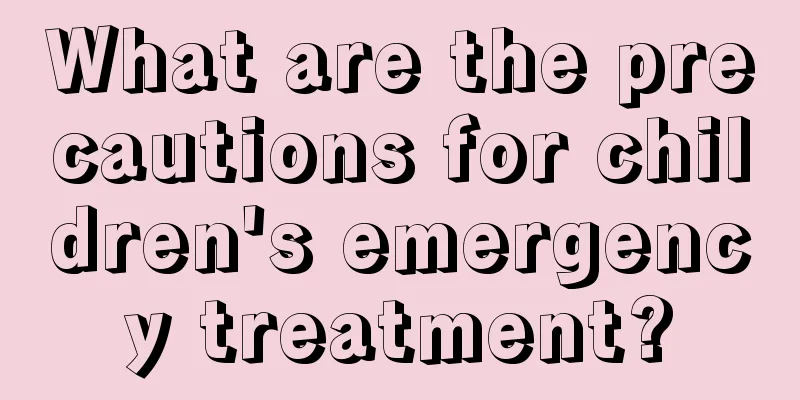What happens if my child has diarrhea and bloody stools?

|
Parents are very concerned about their children's health, and the health of their children can often be reflected in the state of their stool. For example, many children will have diarrhea when they have intestinal infections, and some children will have diarrhea and bloody stools. This is relatively rare among parents and will cause them extreme anxiety. Let's take a look at what happens when children have diarrhea and bloody stools? If there is blood in the stool discharged from the anus, whether it is bloody or entirely bloody, and the color is bright red, dark red or tarry, it is called hematochezia. Excessive blood in the stool indicates bleeding in the lower gastrointestinal tract, especially in the colon and rectum. Blood in the stool accompanied by vomiting blood is a manifestation of upper gastrointestinal bleeding. The color of the stool depends on the location of the bleeding, the amount of bleeding and the time it stays in the intestine. Upper gastrointestinal bleeding is mostly black stool. If the amount of bleeding is large and discharged quickly, it may also be dark red or even bright red. Lower gastrointestinal bleeding is mostly bright red or dark red. If it stays in the intestines for a long time, it may turn into black stools. Tarry black stools indicate a bleeding volume of more than 60 ml. People with blood in the stool may not vomit blood, but those with vomiting blood often have black stools. Blood in the stool can also be part of a systemic disease manifestation, and sometimes it can be caused by swallowing blood from outside the digestive tract. 1. Lower gastrointestinal tract diseases (1) Anal canal diseases: anal fissures and hemorrhoids. (2) Rectal diseases: Anal and rectal injuries, rectal polyps, rectal tumors, etc. (3) Colon and small intestinal diseases: bacterial dysentery, amebic dysentery, localized enteritis, intussusception, intestinal tuberculosis, enterotyphoid fever, distal ileal diverticulitis, melanoma-gastrointestinal polyposis, intestinal duplication, small intestinal hemangioma, small intestinal tumor, mesenteric artery embolism, etc. 2. Upper digestive tract diseases: esophageal, stomach, duodenum, bile duct diseases, etc. 3. Systemic and toxic diseases (1) Bleeding, coagulation disorders, blood diseases, neonatal hemorrhagic disease, severe infection and DIC, etc. (2) Acute infectious and parasitic diseases: hemorrhagic fever, typhoid, paratyphoid and typhus, leptospirosis, hookworm disease, schistosomiasis, sepsis, etc. (3) Poisoning or drug toxicity: sepsis, bacterial food poisoning, poisonous plant poisoning, drug toxicity, chemical poisoning, etc. (4) Hereditary hemorrhagic telangiectasia The above diseases cause intestinal inflammation and ulcers, intestinal blood circulation disorders, gastrointestinal mucosal damage or increased capillary permeability, leading to bloody stools. |
<<: What happens if my child has blood in his stool?
>>: What should I do if my child gets prickly heat on his back?
Recommend
What are the symptoms of lung heat in babies? How to care
Lung heat is a common clinical problem, and this ...
How to provide first aid for children with concussion?
In daily life, children's heads are the most ...
What is the reason for baby's puffiness?
Many parents nowadays do not realize that babies ...
Baby medicine dispenser
The baby's physical development is not yet co...
Why does my baby urinate less?
The birth of a baby is a very happy thing for eve...
What are the early symptoms of avascular necrosis of the femoral head in children?
In our impression, femoral head necrosis should o...
Can a child who has had chickenpox get it again?
Many people have had chickenpox in childhood. As ...
Can children eat candy when they have a cough?
Candy is a kind of snack that many children like ...
What are the main symptoms of neonatal cerebral palsy?
The birth of a baby represents new hope and is so...
Symptoms of runny nose in babies
A baby's runny nose means that the baby is si...
How to deal with children's throat choking
Children's throats are very fragile. If they ...
Reasons why babies hum when they sleep
Children with poor immunity often experience abno...
How to identify baby's O-shaped legs
When many babies are young, their mothers will ch...
What does it mean when a toddler grinds his teeth while sleeping at night?
Many parents of young children have discovered a ...
What medicine should I take for my baby's cough without phlegm?
Because babies' organs are not yet fully deve...









